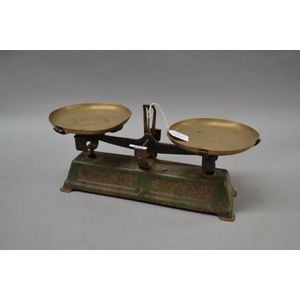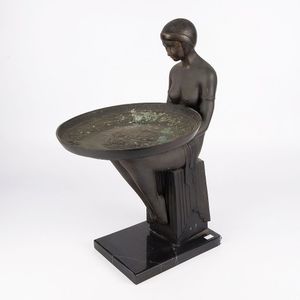Art Deco Bronze Figural Tray on Marble Socle
Max Le Verrier (French 1891-1973) attributed, large Art Deco bronze figural dish or card tray on a black marble socle
You must be a subscriber, and be logged in to view price and dealer details.
Subscribe Now to view actual auction price for this item
When you subscribe, you have the option of setting the currency in which to display prices to $Au, $US, $NZ or Stg.
This item has been sold, and the description, image and price are for reference purposes only.
- Art Deco Period - The Art Deco period was a cultural movement that emerged in the 1920s and 1930s, and was characterized by its emphasis on modernism, luxury, and elegance. The name "Art Deco" comes from the Exposition Internationale des Arts Décoratifs et Industriels Modernes, a large exhibition held in Paris in 1925 that showcased the latest trends in decorative arts.
Art Deco was a reaction against the ornate and elaborate styles of the previous era, and reflected a new modern sensibility. It was characterized by streamlined, geometric shapes, bright colours, and the use of new materials such as chrome, glass, and Bakelite. Art Deco designers sought to create a sense of luxury and sophistication, often incorporating expensive materials such as ivory, marble, and rare woods.
Art Deco had a significant impact on a wide range of artistic fields, including architecture, fashion, graphic design, and interior design. Some of the most iconic examples of Art Deco architecture include the Empire State Building in New York City, the Hoover Building in London, and the Palais de Chaillot in Paris.
The Art Deco period came to an end in the 1940s, as World War II and changing cultural trends led to a shift in artistic styles. However, Art Deco remains an important influence on design and art, and continues to be celebrated for its modernist sensibility and glamorous aesthetic. - Bronze - An alloy of copper and tin, traditionally in the proportions of about 9 parts of copper to 1 part of tin.
The discovery of bronze in Western Asia in the 4th century enabled people to create metal objects which were superior to those previoulsy possible because of its strength and hardness, and it has been used throughout the world for weapons, coins, tools, statuary and other decorative items.
It is very fluid in a molten state, and its hardness, strength when set, and non-corrosive properties makes it most suitable for casting sculpture. - Attributed - A cataloguing term where the item in the opinion of the cataloguers, is a of the period of the artist, craftsman or designer, and which probably in whole or part is the work of that person.
- Socle - The short plinth, usually cylindrical, that serves as a pedestal for a sculpture or vase
This item has been included into following indexes:
Visually similar items

Set of French vintage painted scales, approx 44 cm long
Sold by
in
for
You can display prices in $Au, $US, $NZ or Stg.

French force cast iron balance scales with two copper bowls, holds fifteen kilos. Length of base 44 cm
Sold by
in
for
You can display prices in $Au, $US, $NZ or Stg.

Pokerwork kookaburra smokers stand with a match holder & a pipe holder. Height 88 cm
Sold by
in
for
You can display prices in $Au, $US, $NZ or Stg.

Set of shop scales with measuring weights, 1 lb. 8 oz, 4 oz, 2 oz and 1 oz
Sold by
in
for
You can display prices in $Au, $US, $NZ or Stg.
